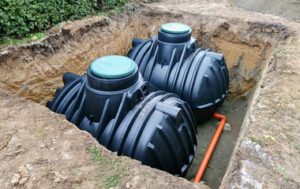What Are Septic Tanks?
When you live in a rural area and aren’t connected to the city sewer system, you need a septic tank to dispose of waste.

These tanks can be made from concrete, fiberglass, plastic or steel. You’ll need to choose a tank based on your soil’s acidity levels and how you plan to use it.
A septic tank is installed underground and catches wastewater from your sinks, toilets and drains. The waste is collected until it is pumped out during periodic maintenance. This keeps your home and yard free of sewage, which can be a health hazard and can cause damage to wood, tile and linoleum if not cleaned regularly.
The cost of installing a septic tank depends on the type of tank and the materials used for its construction. Choosing a quality tank can save you money in the long run, as it will last much longer than a cheaper unit that could be leaking and failing within a few years.
Septic tanks can be made from concrete, fiberglass, steel and plastic. Concrete and plastic are the most popular materials for septic tanks, but they can be more expensive than fiberglass.
Steel septic tanks are more affordable than concrete or fiberglass units, but they are the least durable. They only last for 25 years before beginning to rust, which means they are not as common as other tank types on the market today.
Fiberglass septic tanks are more expensive than concrete or plastic units, but they are more durable, and they can last for up to 20 or 30 years. They are also more lightweight than heavier material tanks, so they can be more convenient for installation.
Piping carries waste from the house to the septic tank and from there into the drain field. Piping can be made of PVC, polyethylene or concrete and costs around $100 to $200 per 100 feet.
Installing a septic tank is an expensive project, but it’s worth the investment if you want to protect your home and yard from wastewater backups. The price can range from $2,000 to $10,000 for a septic tank and associated pipework, including a pump.
The cost of a septic tank also depends on whether you’re able to get it on your property or need to have an existing one removed. To have a new tank placed on your property, you will need to get a permit and clear the land to build it on.
Septic tanks are a common solution for wastewater treatment, and they have many benefits over sewer lines. They are cheaper to install, don’t require monthly maintenance, and can last for a long time when properly maintained.
A septic tank is an underground chamber in which waste water from your home or business is collected, cleaned and stored until it’s emptied. It can be made of a variety of different materials, including concrete, steel and fiberglass.
When you flush your toilet or use your sink, the waste water is sent through pipes into the septic tank. Afterward, the waste is filtered by the soil and bacteria that live on or near the ground, making it safe for reuse.
Unlike sewer systems, septic tanks do not discharge waste into the environment, but rather they drain a third of their contents to a soakaway or drainage field that sits underneath your property. This allows the water to get partially cleaned by the soil, and it naturally replenishes local water tables, helping wildlife to thrive in your area.
Septic tanks don’t clog as quickly as sewer lines, and they don’t emit odors or cause any damage to the surrounding landscape, so they are a good choice for properties that need to be located in rural areas. Moreover, septic tanks can be much less expensive than laying sewer lines out to your property and are usually installed underground.
Some septic tanks are made from fiberglass, which makes them more durable, and they don’t crack or rust like concrete and steel tanks. Fiberglass septic tanks are also lighter than other types of tanks, which means they can be easier to install. However, these tanks are prone to shifting when the surrounding soil becomes saturated, so you should be careful when installing them.
